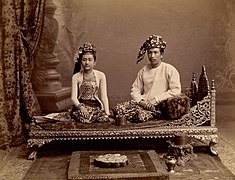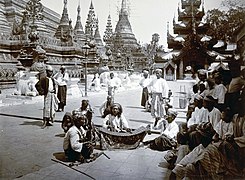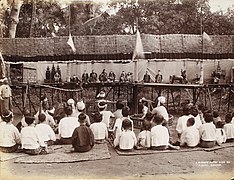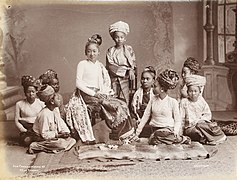Philip Adolphe Klier
Philip Adolphe Klier | |
|---|---|
| Born | 1845, |
| Died | 27 March 1911 (aged 65–66) |
| Nationality | Germany |
| Occupation | photographer, optician, watchmaker |
| Known for | photographs of 19th-century Burma |
Philip Adolphe Klier (c. 1845 in Offenbach, German Confederation – 27 March 1911 in Rangoon, Burma), also known as Philip Klier, was a German photographer, who arrived in British Burma as a young man around 1845 and spent the rest of his life there. Working as optician, watchmaker, self-trained photographer and art dealer, Klier took hundreds of photographs at the end of the 19th century during the British colonial period in Burma. His photographs, taken both in his studio as well as on location, were sold as postcards for foreign visitors. They have been published in several books and collected in public archives. Among a small number of other photographers, Klier is considered as one of the earliest professional photographers in the history of today's Myanmar.[1]
Life and work[]

Beginnings in Moulmein[]
After having emigrated from Germany, Klier first settled in Moulmein (now Mawlamyine, Mon State), the first capital of British Burma, in 1865, and started to work as a watchmaker in a small community of German watchmakers, opticians and photographers. Having acquired the technical skills of photography under the given climatic conditions, he set up his first studio in Moulmein.[2]
Expanding business in Rangoon[]
After 1880, Klier and his family moved to the capital Rangoon, where he operated from his studio in Signal Pagoda Rd. and found better chances for selling his photographs. The customers were mainly British and other foreign officers, businessmen and visitors. For five years after 1885, Klier temporarily entered a partnership with J. Jackson, an established British studio photographer,[3] but after that, he continued working on his own.[4][5] After 1906, some of Klier's photographs were copied by the company D. A. Ahuja, (or T. N. Ahuja, Rangoon), and sometimes sold as hand-coloured postcards.[2]
In 1907, P. Klier & Co sold photographic supplies to the growing demand by photographers and advertised ‘[t]he largest selection of views of Burma and pictorial postcards’ in Thacker's Indian Directory.[6] The 1908 edition of Thomas Cook & Sons Burma. Information for travellers landing at Rangoon printed eight out of a total of fifteen photographs by "Messrs. P. Klier & Co",[2] whose studio was conveniently located in a building next to Thomas Cook's travel agency.[7]
Portraits and scenes of everyday life[]
The wide range of Klier's images documents his strong interest in both colonial British as well as Burmese life and culture.[5] Many of his photographs were printed as albumen prints, the most popular photographic printing technique of the late 19th century. As the technical possibilities of photography developed, so did his approach to presenting the subjects of his portraits: the two early portraits of a young English lady in the style of cabinet cards, taken around 1894 and archived at the National Portrait Gallery in London,[8] or the portrait of an unknown man archived next to his business card, attest to the portrait style of the late 1890s. They stand in contrast with his later portraits, such as the picture of a Burmese lady on a hand-colored photoprint on postcard after an original albumen print of 1907, with a blurred background and crisp details of her person, clothes or jewellery in the foreground.
Apart from photographic portraits of Europeans and scenes of busy areas of Rangoon, Klier also carefully staged and recorded portraits of Burmese people in traditional attire, such as a princess and her following or a chief from the princely Shan States in eastern Burma shown below. Beside studio portraits for individual customers, Klier showed an interest in everyday street scenes, as by documenting traditional musicians or audiences watching the popular Burmese puppet shows (Yoke thé) of the times. Other scenes show Burmese at work, such as elephants and their keepers at work in timber yards or on paddy boats carrying rice. Klier also took photographs of famous buildings, like Burma's most important religious monument, the Shwedagon Pagoda[9] or the great mosque[10] in Rangoon. Other street scenes of colonial Rangoon include the historical Strand Hotel.
Critical reception[]
In his book on the history of photography in Burma, art historian Noel Francis Singer characterized Klier's approach as follows: "Klier had an eye for the unusual and many religious buildings which would have been ignored by another were fortunately immortalized by him."[1]
Many of Klier's photographs have been archived and digitised by the British Library[11] and the National Archives in the United Kingdom[12] as well as by the Smithsonian Institution in the United States.[13] His work has also been published as part of the photographic collection of the Guimet Museum of Asian Arts in Paris, France,[14] the Ethnological Museum of Berlin, Germany,[2] and in the online collection of the Nederlands Photo Museum Rotterdam.[15]
Gallery[]

Burmese couple in the 1890s

Burmese musicians at the Shwedagon Pagoda

A traditional Burmese puppet show

Burmese monks and novices, 1907

Detail of Burmese Paddy boat, 1907

Elephants at work in Rangoon, 1907

Shan princess and followers, 1907

A Shan chief, sitting on a cusion

A Burmese lady, hand-colored photoprint
See also[]
Other notable photographers of 19th-century Burma:
References[]
- ^ a b Singer, Noel Francis (1993). Burmah: a photographic journey, 1855–1925, p.8. P. Kiscadale. ISBN 978-1-870838-26-9.
- ^ a b c d Bautze, Joachim K. (2014). ""P. Klier, Rangoon, British Burma, 1893": Zur Frage der Zuschreibung". In Platz, Roland (ed.). Myanmar im Spiegel der historischen Fotografie (in German). Leipzig: E. A. Seemann. pp. 39–43. ISBN 9783865023490.
- ^ See, for example, Johnson's photograph of a Burmese Minister in Court Dress.
- ^ "A look into the life of one of Burma's earliest photographers". The Myanmar Times. 2 January 2019. Retrieved 9 October 2019.
- ^ a b "Burmese days: the extraordinary photos of Philip Adolphe Klier". itchyfeetandmore.com. 1 March 2014. Retrieved 9 October 2019.
{{cite web}}: CS1 maint: url-status (link) - ^ Thacker’s Indian directory 1907:562–575
- ^ Sadan, Mandy (1 January 2014). "The Historical Visual Economy of Photography in Burma". Bijdragen tot de Taal-, Land- en Volkenkunde / Journal of the Humanities and Social Sciences of Southeast Asia. 170 (2–3): 281–312. doi:10.1163/22134379-17002024. ISSN 0006-2294.
- ^ "Philip Adolphe Klier – National Portrait Gallery". www.npg.org.uk. Retrieved 15 December 2019.
- ^ "Gold-Covered Stupa at Shwedagon Pagoda". Getty Images. Retrieved 17 December 2019.
- ^ "The Mosque Rangoon". Getty Images. Retrieved 17 December 2019.
- ^ "Explore the British Library Search - Philip Adolphe Klier". explore.bl.uk. Retrieved 27 December 2021.
- ^ The National Archives. "The Discovery Service". discovery.nationalarchives.gov.uk. Retrieved 16 December 2019.
{{cite web}}: CS1 maint: url-status (link) - ^ "Search results for: Klier, Adolphe, page 1 | Collections Search Center, Smithsonian Institution". collections.si.edu. Retrieved 4 October 2021.
- ^ Ghesquière, Jérôme; Makariou, Sophie (2018). L'Asie des photographes (in French). Paris: Réunion des Musées Nationaux. pp. 77–97. ISBN 978-2-7118-7096-7. OCLC 1065528119.
- ^ Klier, Philip Adolphe. "Collecties | Nederlands Fotomuseum Rotterdam". collectie.nederlandsfotomuseum.nl. Retrieved 10 November 2021.
{{cite web}}: CS1 maint: url-status (link)
Further reading[]
- Hannavy, John, ed. (2007). Encyclopedia of Nineteenth-Century Photography. Routledge. p. 1317. ISBN 978-1-135-87327-1.
- Platz, Roland, ed. (2014). Myanmar im Spiegel der historischen Fotografie (in German). Leipzig: E. A. Seemann. p. 160. ISBN 9783865023490.
- Museé national des arts asiatiques-Guimet, ed. (2017). Images birmanes, 1865-1909: trésors photographiques du Musée national des arts asiatiques Guimet (in French). Paris: Cohen & Cohen. ISBN 978-2-36749-045-8. OCLC 1019839807.
External links[]
| Wikimedia Commons has media related to Philip Adolphe Klier. |
- Sadan, Mandy. "The Historical Visual Economy of Photography in Burma." In Bijdragen Tot De Taal-, Land- En Volkenkunde 170, no. 2/3 (2014): 281–312.
- Burma in The Encyclopedia of Nineteenth Century Photography, p. 1317
- Collection of photographs by Philip Adolphe Klier on flickr.com
- Luminous-lint: Photography: History, evolution and analysis on Klier
- 88 photographs by Philip Adolphe Klier in the British Library online gallery
- 1845 births
- 1911 deaths
- Photography in Myanmar
- History of Myanmar
- Burmese culture
- 19th-century German photographers
- 19th century in Burma
- German emigrants to Myanmar








